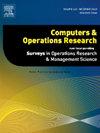Capacity planning to cope with demand surges in fourth-party logistics networks under chance-constrained service levels
IF 4.1
2区 工程技术
Q2 COMPUTER SCIENCE, INTERDISCIPLINARY APPLICATIONS
引用次数: 0
Abstract
In this paper, we study a capacity planning problem for a fourth-party logistics network (4PLN) in the face of event-triggered demand surges. We aim to solve a stochastic optimization problem in order to minimize the total cost for the 4PLN under chance-constrained service-level targets, where the stochastic demand process is modeled as a summation of random variables with a Bernoulli term of jump processes. At the heart of our solution procedure is a greedy pricing and weighting strategy based cell-and-bound (G-C&B) algorithm designed for solving the SAA-based model. Compared to the standard C&B method, our G-C&B is able to largely reduce the number of non-essential cell enumerations and achieve reduced running time complexity. To mitigate the performance degradation due to large system scale and/or sample instance, we extend our base algorithm to a two-step Local Experimentation for Global Optimization strategy based cell-and-bound (LEGO-C&B) framework, in which we first solve a small-scale training problem to find the important scenarios (eliminating excessive cell enumerations) and then use the training results to expedite the full optimization problem. We evaluate the performance of our algorithms by conducting a comprehensive series of numerical experiments. Besides, our results also demonstrate how the effectiveness of our methods depends on various factors including (i) the algorithm’s hyperparameters such as the sample size and training ratio, and (ii) the 4PLN’s input parameters such as the network scale, surge demand frequency, and rental price of 3PL resource. Our results exhibit several qualitative insights.
求助全文
约1分钟内获得全文
求助全文
来源期刊

Computers & Operations Research
工程技术-工程:工业
CiteScore
8.60
自引率
8.70%
发文量
292
审稿时长
8.5 months
期刊介绍:
Operations research and computers meet in a large number of scientific fields, many of which are of vital current concern to our troubled society. These include, among others, ecology, transportation, safety, reliability, urban planning, economics, inventory control, investment strategy and logistics (including reverse logistics). Computers & Operations Research provides an international forum for the application of computers and operations research techniques to problems in these and related fields.
 求助内容:
求助内容: 应助结果提醒方式:
应助结果提醒方式:


